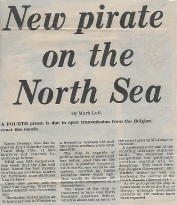





|
1970s |
|
|
|
|
|
(Anchored off the Netherlands, target audience the Netherlands) |
|
|
|
Radio North Sea International (RNI) (Anchored off the Netherlands and Britain - |
|
|
|
(Anchored off the Netherlands, target audience the Netherlands) |
|
|
|
(Anchored off the Netherlands and Britain - |
|
|
|
(Anchored off Belgium, target audience Belgium and the Netherlands) |
|
|
|
(Anchored off the Netherlands - |
|
|
|
(Anchored off the Netherlands and Britain - |
|
|
|
(Anchored off the Netherlands, target audience the Netherlands) |
|
|
|
(Anchored off the Netherlands, target audience the Netherlands) |









|
1980s |
|
|
|
|
|
(Anchored off the Netherlands, target audience Netherlands) |
|
|
|
(Anchored off Britain, target audience the Netherlands) |
|
|
|
(Anchored off Britain, target audience the Netherlands) |
|
|
|
(Anchored off Britain, target audience the Netherlands) |






|
|
Radio Marina |
|
|
SOR (Stichting Radio Operatie) |
|
|
Radio 199 |
|
|
Radio Condor |
|
|
Radio Benelux |
|
|
Radio Nova International |
|
|
Radio Hollandia |
|
|
Radio Mauritius |
|
|
Mighty 690 |
|
1960s |
|
|
|
|
|
(Anchored off the Netherlands, target audience Netherlands) |
|
|
|
(Anchored off the Netherlands, target audience Britain) |
|
|
|
(Anchored off Belgium, target audience Belgium) |
|
|
|
(Positioned off the Netherlands, target audience Netherlands) |
|
|
|
(Anchored off Britain,target audience the Netherlands) |
|
|
|
(Anchored off Britain, target audience the Netherlands) |



RADIO
227



































